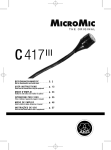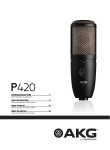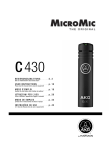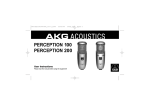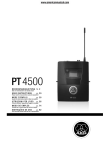Download user manual - Warehouse Sound Systems
Transcript
C 417 III BEDIENUNGSHINWEISE . . . . . . . . . . . . . S. 2 Bitte vor Inbetriebnahme des Gerätes lesen! USER INSTRUCTIONS . . . . . . . . . . . . . . . p. 13 Please read the manual before using the equipment! MODE D’EMPLOI . . . . . . . . . . . . . . . . . . . . . . p. 24 Veuillez lire cette notice avant d’utiliser le système! ISTRUZIONI PER L’USO . . . . . . . . . . . . . p. 35 Prima di utilizzare l’apparecchio, leggere il manuale! MODO DE EMPLEO . . . . . . . . . . . . . . . . . . . p. 46 Antes de utilizar el equipo, sirvase leer el manual! INSTRUÇÕES DE USO . . . . . . . . . . . . . . . Favor leia este manual antes de usar o equipamento! p. 57 1 Precaution/Description Please make sure that the piece of equipment your microphone will be connected to fulfills the safety regulations in force in your country and is fitted with a ground lead. 1.1 Precaution 1.2 Unpacking 1 C 417III 1 W 407 1 H 40/1 1 H 41 Check that the packaging contains all of the components listed above. Should anything be missing, please contact your AKG dealer. • MK 9/10 microphone cable: 10-m (30-ft.) 2-conductor shielded cable w/male and female XLR connectors 1.3 Optional Accessories • MPA III L phantom power adapter • B 29 L, B 15 battery power supplies • N 62 E, N 66 E, B 18 phantom power suppplies • Professional miniature clip-on microphone. • Omnidirectional condenser transducer for natural sound. • Extended frequency response for clear reproduction of speech, vocals, violin. 1.4 Features 13 1 Description • Fastens on clothing or directly on the user's head. 1.5 Brief Description The C 417III is a professional miniature condenser clip-on microphone with an omnidirectional polar pattern. With its wide frequency range extending from 20 Hz to 20 kHz, low distortion at high sound pressure levels, small size, and useful accessories, the C 417III is an ideal choice for use in any situation requiring an inconspicuous microphone and maximum mobility for the user. The microphone is available in two different colors and will almost disappear when blended in with an actor's or singer's makeup. An external windscreen supplied with the microphone reduces wind noise when using the microphone on an open-air stage. 1.6 Versions C 417III PP: The C 417III is available in three versions: • With 3-pin XLR connector with integrated adapter for 9 to 52 V universal phantom power. • With locking mini XLR connector for use with the B 29 L battery power supply, MPA III L phantom power adapter, or AKG bodypack transmitters. • Identical to the C 417III L, except with fleshcolor cable and microphone body. C 417III L: C 417III PL: 14 2 Interfacing The C 417III is a condenser microphone and therefore needs a power supply. 2.1 Introduction Using any power supply other than those recommended by AKG may damage your microphone and will void the warranty. Important! 1. Connect the phantom power adapter (1) on the microphone cable to a balanced XLR microphone input with phantom power. 2. Switch the phantom power on. (Refer to the instruction manual of the unit to which you connected your microphone.) 2.2 C 417III PP 2.2.1 Connecting to Balanced Inputs Refer to fig. 1. XLR XLR 1 Phantom 2 1 3 Fig. 1: Connecting to a balanced input. 3. If your mixer provides no phantom power: Connect the phantom power adapter (1) to an optional AKG phantom power supply (2) (N 62 E, N 66 E, B 18, B 15) and use an XLR cable (3) (e.g., an optional MK 9/10 from AKG) to connect the phantom power supply to the desired balanced input. Refer to fig. 1. You may connect any AKG phantom power supply (2) to an unbalanced input, too. Use a cable (3) with a female XLR connector and TS jack plug: 2.2.2 Connecting to Unbalanced Inputs Refer to fig. 2. 15 2 Interfacing 2 XLR 5 4 Phantom 3 1 Fig. 2: Connecting to an unbalanced input. 1. On the XLR connector (4), add a wire bridge to connect pin 1 to pin 3 and the cable shield. 2. Connect the inside wire of the cable to pin 2 on the XLR connector (4) and the tip contact of the jack plug (5). Note: Unbalanced cables may pick up interference from stray magnetic fields near power or lighting cables, electric motors, etc. like an antenna. This may introduce hum or similar noise when you use a cable that is longer than 16 feet (5 m). 2.3 C 417III L/PL 2.3.1 Using the Optional B 29 L Refer to fig. 3. Connecting the cable: The optional B 29 L battery supply allows you to connect the microphone to balanced or unbalanced inputs with no phantom power. Disconnecting the cable: To disconnect the cable, press the unlocking button on the mini XLR connector (1) and pull the connector (1) out of the socket. 16 1. Push the mini XLR connector (1) on the microphone cable into one of the two mini XLR sockets on the B 29 L (2) to the stop. The connector will lock automatically. 2 Interfacing 1 3 B 29 L 2 4 5 Fig. 3: Using the B 29 L to power the microphone. To avoid damaging the cable, never try to pull out the cable itself! 2. Connect the B 29 L (2) to the desired input. Important! Refer to fig. 3. • Use a commercial XLR cable (3) to connect the B 29 L (2) to a balanced input. Balanced input: • Refer to section 2.2.2 above. Unbalanced input: 1. Push the mini XLR connector (1) on the microphone cable into the mini XLR socket (2) on the cable of the MPA III L (3) to the stop. The connector will lock automatically. Refer to section 2.3.1 above. 2.3.2 Using the MPA III L Refer to fig. 4. Disconnecting the cable: 2. Connect the MPA III L (3) to a balanced XLR microphone input with phantom power. 3. Switch the phantom power on. (Refer to the instruction manual of the unit to which you connected your microphone.) 17 2 Interfacing Mini XLR 1 MPA Mini XLR MPA 2 3 Phantom 3 5 4 Fig. 4: Connection diagram with MPA III L. Refer to fig. 4. 4. If your mixer provides no phantom power: Connect the MPA III L (3) to an optional AKG phantom power supply (4) (N 62 E, N 66 E, B 18, B 15) and use an XLR cable (5) (e.g., an optional MK 9/10 from AKG) to connect the phantom power supply (4) to the desired balanced input. 2.3.3 Connecting to a Bodypack Transmitter Refer to the manual of your bodypack transmitter. 18 3 Using Your Microphone The principal benefit of a microphone attached to the user's clothes or integrated in their makeup is that the microphone will maintain a constant working distance independently of the user's movements and thus ensure a constant output level. Also, a clip-on microphone allows the user to move about freely and keeps their hands free. 3.1 Introduction 3.2 Lavalier Miking a Fig. 5: Fixing the microphone on the clip (a) or tie pin (b). b 1. Insert the cable into one of the fixing grooves on the supplied H 40/1 clip (se fig. 5a) or on the supplied H 41 tie pin (see fig. 5b), at a point immediately behind the microphone body. min. Fig. 6: Attaching the microphone near the user's mouth. 2. Attach the microphone to the talker's clothes, e.g., on the lapel, placing it as close as possible to the talker's mouth. 19 3 Using Your Microphone Note: The smaller the distance between the microphone and the sound source, the higher the usable gain before feedback. 3.3 Live Recording and Spot Miking 1. Insert the cable into one of the fixing grooves on the supplied H 40/1 clip (se fig. 5a) or on the supplied H 41 tie pin (see fig. 5b). 2. Fix the microphone on a suitable part of the stage decoration such as a flat, backdrop, curtain, etc. 3.4 Theater, Musical, Opera Fig. 7: Microphone integrated in performer's makeup. Fix the microphone on the user's head, as close as possible to the mouth, and blend it in with the makeup. Many engineers place the microphone as shown in fig. 7. Depending on the requirements of the production at hand, you may also attach the microphone in different places, e.g., on the performer's forehead. 20 3 Using Your Microphone 3.5 Violin Fig. 8: Miking up a violin. If the production concept does not allow for microphones mounted on the the violin itself, you can attach the microphone with mastic to the violinist's cheek. Refer to fig. 8. This method provides the following benefits: • Since the microphone is not mounted on the violin itself, it will not affect the sound of the instrument. • There will be no risk of damaging the violin with adhesive tape or similar mounting materials. • There will be no cable that gets in the way. 4 Cleaning To clean the microphone case, use a soft cloth moistened with water. 21 5 Troubleshooting Problem Possible Cause Remedy No sound: 1. Power to mixer 1. Switch power to and/or amplifier is mixer or amplifier off. on. 2. Channel or master 2. Set channel or fader on mixer, or master fader on volume control on mixer or volume amplifier is at zero. control on amplifier to desired level. 3. Microphone is not 3. Connect microconnected to mixphone to mixer or er or amplifier. amplifier. 4. Cable connectors 4. Check cable are seated loosely. connectors for secure seat. 5. Cable is defective. 5. Check cable and replace if damaged. 6. No supply voltage. 6. Switch phantom power on. Phantom power supply: connect to power outlet or insert battery (batteries). Check cable and replace if necessary. Distortion: 1. Gain control on the mixer set too high. 2. Mixer input sensitivity too high. 22 1. Turn gain control down CCW. 2. Connect a 10-dB preattenuation pad between microphone cable and input. 6 Specifications Type: Polar pattern: Frequency range: Sensitivity at 1 kHz: Impedance: Recommended load impedance: Max. SPL for 1%/3% THD: Equivalent noise level: Power requirement: pre-polarized condenser microphone omnidirectional 20 Hz to 20,000 Hz 10 mV/Pa (-40 dBV re 1 V/Pa) 200 2000 118/126 dB SPL 34 dB (A) (to IEC 60268-4) C 417III PP: 9 to 52 V universal phantom power C 417III L/PL: B 29 L battery power supply, MPA III L phantom adapter, or AKG WMS bodypack transmitters Current consumption: approx. 2.2 mA Cable length/Connector: C 417III PP: 3 m (10 ft.) / 3-pin male XLR C 417III L/PL: 1.5 m (5 ft.) / 3-pin mini XLR Finish: matte black (PP, L) or flesh-color (PL) Size: 7.5 x 15 mm (0.3 x 0.6 in.) Net/shipping weight: C 417III PP: 8 g (0.3 oz.) / 220 g (7.8 oz.) C 417III L/PL: 8 g (0.3 oz.) / 160 g (5.6 oz.) This product conforms to the standards listed in the Declaration of Conformity. To order a free copy of the Declaration of Conformity, visit http://www.akg.com or contact [email protected]. Frequency Response Polar Diagram 23












